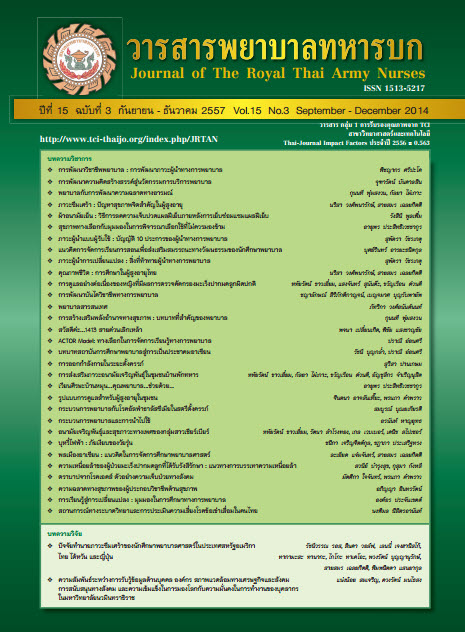ปัจจัยที่มีความสัมพันธ์ต่อการควบคุมระดับน้ำตาลในเลือดของผู้เป็นเบาหวาน ชนิดที่สอง โรงพยาบาลพระมงกุฎเกล้า
Keywords:
ผู้เป็นเบาหวานชนิดที่ 2, พฤติกรรมการดูแลสุขภาพ, การสนับสนุนทางสังคม, การควบคุมระดับน้ำตาลในเลือด, Type 2 diabetes mellitus, health care behaviors, social support, glycemic controlAbstract
การวิจัยครั้งนี้มีวัตถุประสงค์เพื่อศึกษาความสัมพันธ์ระหว่างปัจจัยส่วนบุคคล ความรู้เกี่ยวกับโรคเบาหวาน การสนับสนุนทางสังคมและพฤติกรรมการดูแลสุขภาพกับการควบคุมระดับน้ำตาลในเลือดของผู้เป็นเบาหวานชนิดที่ 2 กลุ่มตัวอย่าง คือ ผู้เป็นเบาหวานชนิดที่ 2 ที่มารับบริการในคลินิกเบาหวาน แผนกผู้ป่วยนอก โรงพยาบาลพระมงกุฎเกล้า ระหว่างเดือนมิถุนายน ถึงเดือนกรกฎาคม พ.ศ. 2556 จำนวน 312 คน การเลือกกลุ่มตัวอย่างเป็นการเลือกแบบเจาะจง เครื่องมือที่ใช้ในการวิจัย เป็นแบบสอบถามประกอบด้วย ession)ข้อมูลส่วนบุคคล ความรู้เกี่ยวกับโรคเบาหวาน การสนับสนุนทางสังคม และพฤติกรรมการดูแลสุขภาพ (ค่าความเชื่อมั่นของแบบสอบถามเท่ากับ 0.71, 0.71, และ 0.93 ตามลำดับ) วิเคราะห์ข้อมูลใช้สถิติ ความถี่ ร้อยละ ค่าความถดถอยโลจิสติก(Binary Logistic Regression) ผลการศึกษา พบว่า ผู้เป็นเบาหวานชนิดที่ 2 มีความรู้เกี่ยวกับโรคเบาหวานอยู่ในระดับต่ำ (ร้อยละ 75.32) การสนับสนุนทางสังคมและพฤติกรรมการดูแลสุขภาพอยู่ในระดับสูง (ร้อยละ 66.03 และ 96.15 ตามลำดับ) การศึกษาด้านความสัมพันธ์พบว่า ปัจจัยส่วนบุคคล ได้แก่ เพศ อายุ และระยะเวลาการเกิดโรคมีความสัมพันธ์กับการควบคุมระดับน้ำตาลในเลือดอย่างมีนัยสำคัญทางสถิติที่ระดับ .05 และ .001 ตามลำดับ ผู้เป็นเบาหวานชนิดที่ 2 เพศหญิง มีโอกาสที่จะไม่สามารถควบคุมระดับน้ำตาลในเลือดได้ (HbA1C ≥ 7) มากกว่าผู้เป็นเบาหวานชนิดที่ 2 เพศชาย เป็น 1.72 เท่า (ORadj = 1.72, 95% CI = 0.32 - 1.04) ผู้เป็นเบาหวานที่มีอายุมากกว่า 60 ปีขึ้นไป มีโอกาสที่จะไม่สามารถควบคุมระดับน้ำตาลในเลือดได้ (HbA1C ≥ 7) มากกว่าผู้เป็นเบาหวานชนิดที่ 2 ที่มีอายุน้อยกว่า 60 ปี เป็น 2.88 เท่า (OR
adj = 2.88, 95% CI = 1.60 - 5.22) และผู้เป็นเบาหวานชนิดที่ 2 ที่มีระยะเวลาการเป็นโรคมากกว่า 10 ปีขึ้นไป มีโอกาสที่จะไม่สามารถควบคุมระดับน้ำตาลในเลือดได้ (HbA1C ≥ 7) มากกว่าผู้เป็นเบาหวานชนิดที่ 2 ที่มีระยะเวลาการเป็นโรคน้อยกว่า 10 ปี เป็น 3.06 เท่า (ORadj= 3.06, 95% CI = 0.19 - 5.64) ส่วนปัจจัยทางด้านความรู้เกี่ยวกับโรคเบาหวาน การสนับสนุนทางสังคม และปัจจัยด้านพฤติกรรมการดูแลสุขภาพ ไม่มีความสัมพันธ์ กับการควบคุมระดับน้ำตาลในเลือดของผู้เป็นเบาหวานชนิดที่ 2 ผลการวิจัย พบว่า การพัฒนารูปแบบการดูแลผู้เป็นเบาหวานชนิดที่ 2 ต้องคำนึงถึงปัจจัยด้านเพศ อายุ และระยะเวลาการเป็นโรค โดยเน้นความเป็นปัจเจกบุคคลของผู้ป่วย เพื่อตอบสนองความต้องการอย่างเหมาะสม ทำให้ผู้เป็นเบาหวานชนิดที่ 2 สามารถดูแลตัวเองและควบคุมระดับน้ำตาลในเลือดได้ดีขึ้น
The Objective of this research was to study the relationship between personal factors, knowledge of diabetes, social support, health care behaviors and glycemic control in type 2 DM patients. The Sample was 312 type 2 DM patients receiving services in diabetic clinic, Phramongkutklao hospital, during June - July 2013. Data collection instruments used in the study were questionnaires consisting of personal information, knowledge of diabetes, social support and health care behaviors. (The reliability of the questionnaires was 0.71, 0.71, and 0.93, respectively). The data were analyzed by using frequency, percentage, mean, standard deviation and Binary Logistic Regression. The result showed that the knowledge of diabetes were in low levels (75.32 Percent), social support and health care behaviors were in high level (66.03 and 96.15, respectively). For the relationship study, among personal factors, only gender, age and duration of the disease were associated with glycemic control, statistically signifiant at the 0.05 and .001 level, respectively. For people with type 2 diabetes mellitus were females cannot control blood sugar levels (HbA1C ≥ 7) rather than males to 1.72 times. (ORadj = 1.72, 95% CI = 0.32 - 1.04) people with type 2 diabetes mellitus were older than 60 years cannot control blood sugar levels (HbA1C ≥ 7) rather than younger 60 years to 2.88 times. (ORadj= 2.88, 95% CI = 1.60 - 5.22) people with type 2 diabetes mellitus were duration of the disease more than 10 years cannot control blood sugar levels (HbA1C ≥ 7) rather than duration of the disease less 10 years to 3.06 times. (ORadj= 3.06, 95% CI = 0.19 - 5.64) However, there was no signifiant association between knowledge of diabetes, social support, health behavior and glycemic control. The results showed that the development of models of care for type 2 DM patients must take gender,
age and duration of the disease, by focusing on the individual needs of the patients to response appropriately, leading to better self-care and blood sugar control among the patients.
Downloads
Downloads
How to Cite
Issue
Section
License
บทความหรือข้อคิดเห็นใดใดที่ปรากฏในวารสารพยาบาลทหารบกเป็นวรรณกรรมของผู้เขียน ซึ่งบรรณาธิการหรือสมาคมพยาบาลทหารบก ไม่จำเป็นต้องเห็นด้วย
บทความที่ได้รับการตีพิมพ์เป็นลิขสิทธิ์ของวารสารพยาบาลทหารบก
The ideas and opinions expressed in the Journal of The Royal Thai Army Nurses are those of the authors and not necessarily those
of the editor or Royal Thai Army Nurses Association.






